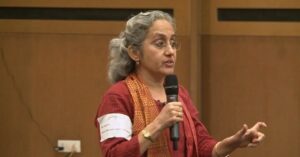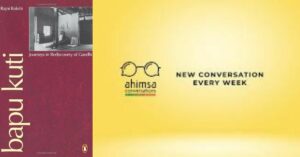On a hot summer day in the month of June in 1975, the people of India were in the midst of a National Emergency that lasted 21 long months. At the time, people were arrested, protests erupted in different parts of the country and people grappled with fear everyday.
It was during this time that Rajni Bakshi, a 17-year-old student at the Indraprastha College in Delhi, had her first encounter with fear and violence which changed her life.
“This was a time before telephones were used widely and a rumour had spread that people were being picked up at random and taken for forced sterilisations. There was a fear of violence. My family did not allow me to go to college that day. That was my first realisation our prevailing sense of peace, often taken for granted, could be put in danger,” Rajni shares with The Better India.
Since then, the concept of non-violence has occupied a central role in her life. And this is what led her to starting her own Youtube channel in her early 60s titled — Ahimsa Conversations. The channel focuses on those actively working with non-violence as well as those whose experiences throw light on its application in the modern world.
On her channel, Rajni invites a wide range of speakers on her channel, from activists like Medha Patkar to scholars like Acharya Shrivatsa Goswami.
These conversations highlight how ahimsa (non-violence) acts as a powerful method of change, even 74 years after India’s independence.

Driven to stop ‘overwhelming hatred’
In 1980, after completing her BA from George Washington University in the United States, she returned to India and pursued an MA in Philosophy, from the University of Rajasthan. After completing her Masters, Rajni worked as a writer with the Indian Express for a year. She then went on to work with The Telegraph for two years.
By 1984, she decided to start working as a freelance journalist and writer and has been doing so for the past 40 years. Today, she writes for leading publications such as The Indian Express, Mint and Firstpost.
Rajni has been exploring the concept of non-violence in her writings, and since 1986 she has written six books. In 1998, inspired by her visit to Bapu Kutir at Sevagram, Maharashtra, she published her book ‘Bapu Kuti: Journeys in Rediscovery of Gandhi’, which tells the stories of the people she met while at Sevagram. The book was also the inspiration behind the film Swades (2004).
Since the 1990s, Rajni has also been a part of the non-violent socio-political movements in India. She has worked with the Narmada Bachao Andolan, Child Rights and You (CRY) and Citizens for Peace.
In early 2019, after spending over two decades of her career as a journalist studying the concept of non-violence, she decided it was time to share her knowledge with others. She was driven by two major reasons at the time to start sharing what she had learnt over the years.
“Firstly, people today are feeling overwhelmed with all the hatred and violence that is present. I wanted to reach out to these people with a positive message. Secondly, in the last 5 or 6 years, I started looking at the concept of non-violence after Gandhi. I felt it was necessary to share what I was learning in real time,” explains Rajni.

A great deal of challenges
When she decided to start her own initiative she wondered whether to write newspaper articles or do videos or a podcast.
So she approached different newspapers in 2019 and they suggested she should do a video series instead, if she wanted to reach a larger audience.
Determined to translate her ideas into a reality, she came up with an elaborate plan which would require lakhs of rupees to start up her own video series. “When you’re enthusiastic about an idea then you don’t give too much thought to what the logistics will be,” says Rajni.
As the months went by, she didn’t get any responses for funding her initiative. So, she decided to start using YouTube to upload her videos. She also wanted to reach as many people as possible through her videos by making them easily accessible.
Her next dilemma was that she had no idea how to go about making videos or sharing them.
With the help of her family and friends, it took the 63-year-old a week’s time to get the hang of how to upload YouTube videos. She began recording the videos in September 2020 and by January this year, she was ready to start her own channel.
Revisiting the idea of non-violence
It was on 30 January 2020 that she decided to launch Ahimsa Conversations, a YouTube channel that “provides viewers with a platform for reflections on the possibility of non-violence and the nature of violence”. She chose to launch the channel on the day keeping in mind that it is celebrated as Martyrs’ Day in India.
“When I first started, my friends said — ‘There’s an explosion of content on the internet. What is the point of adding more?’ But by that logic no song should be sung, no book written and no movie be made. There has always been more content than time that people have to see it, but it’s our responsibility to sing our song irrespective,” says Rajni.
“It is important to share the voices of people whose actions show that non-violence is possible across a wide spectrum. At the same time I wanted to counter the misinformation that non-violence began and ended with Gandhi. Non-violence as a thought, method, aspiration, philosophy long predates Gandhi and continues to be relevant in today’s world,” says Rajni.
Each conversation brings to the front a novel way in which non-violence has been practiced and how we can make it a part of our everyday lives. For instance, the episode with Radha Bhatt, a social activist and environmentalist who has led many initiatives for the empowerment of women and environmental conservation. She tells us how she used the concept of ahimsa to empower the women in her village in Almora district. She recalls a time when she was leading a group of 2,500 women, many who were uneducated, in an anti-liquor agitation. The women surrounded a local liquor shop and when the district magistrate threatened the women with arrest, they sang songs and slogans.
The episode brought out how non-violence is a powerful weapon and can be used to achieve outcomes in a peaceful manner.
Till date, there have been 56 Ahimsa Conversations with people from 14 different countries, including India. The channel has more than 550 subscribers.

Rajni has come a long way from not knowing how to use YouTube to now uploading each video herself. She now makes sure to add subtitles to her videos by herself, as it helps her get a better understanding of the conversations. She credits her learning to the people she has worked with.
All the people working on Ahimsa Conversations are volunteers, apart from video editing which is done by a professional. Every Friday, Rajni makes sure to upload the sessions with each speaker and on Sunday mornings she sends the link of the video to all her WhatsApp contacts. This is the only way she publicises her work.
A ray of hope
Rajni plans to start a new podcast series by converting the videos she has made so far into podcasts as well as recording new ones. She believes that her initiative is a small step in making people realise ahimsa is not just a concept that we read in our history textbooks but is relevant and necessary in today’s world.
“Inevitably, if you follow the news today there are so many things that drag down your morale and make the times that we live in look difficult. Through Ahimsa Conversations I want to keep reiterating that there is this positive energy as well. People are happy to know that there is a platform that is keeping the conversation about non-violence going,” says Rajni.
She hopes to continue the conversations and signs off on a hopeful note.
“I feel like it’s a bit like being a lighthouse. It may look like a very inactive thing but someone has to keep the light going. The light doesn’t bring the ships in, but without the light the ships may never find their way. Similarly, one should be tireless in repeating what you believe is true. We have to keep repeating that non-violence is possible, as difficult as it may be,” says Rajni.
Edited by Yoshita Rao
No comments:
Post a Comment